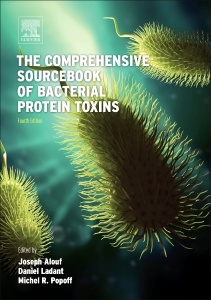Description
The Comprehensive Sourcebook of Bacterial Protein Toxins (4th Ed.)
Authors: Alouf Joseph E., Ladant Daniel, Popoff Michel R.
Language: English
Subjects for The Comprehensive Sourcebook of Bacterial Protein Toxins:
Keywords
Cell biology; pathogenesis; toxicology; bioterrorism; toxin-producing bacteria; mitochondria; plant toxins; genetics; neurotoxins; intracellularly active bacterial protein toxins; target cells; strucutre; mode of action; enterotoxin; clinical applications; immunological aspects; medical applications; engineering; novel therapeutic tools; vaccines; adjuvants; pore-forming toxins; biological weapons
220.63 €
In Print (Delivery period: 14 days).
Add to cartSupport: Print on demand
Description
/li>Contents
/li>Readership
/li>Biography
/li>Comment
/li>
The Comprehensive Sourcebook of Bacterial Protein Toxins, Fourth Edition, contains chapters written by internationally known and well-respected specialists. This book contains chapters devoted to individual toxins, as well as chapters that consider the different applications of these toxins. Considerable progress has been made in understanding the structure, function, interaction and trafficking into cells, as well as mechanism of action of toxins. Bacterial toxins are involved in the pathogenesis of many bacteria, some of which are responsible for severe diseases in human and animals, but can also be used as tools in cell biology to dissect cellular processes or used as therapeutic agents. Novel recombinant toxins are already proposed in the treatment of some diseases, as well as new vaccines. Alternatively, certain toxins are also considered as biological weapons or bioterrorism threats. Given the multifaceted aspects of toxin research and the multidisciplinary approaches adopted, toxins are of great interest in many scientific areas from microbiology, virology, cell biology to biochemistry and protein structure. This new edition is written with a multidisciplinary audience in mind and contains 5 new chapters that reflect the latest research in this area. Other chapters have been combined, deleted and fully revised as necessary to deliver relevant and valuable content.
Section I: Basic Genomic and Physiological Aspects of Bacterial Protein Toxins1. Evolutionary aspects of toxin-producing bacteria2. Mobile genetic elements and pathogenicity islands encoding bacterial toxins3. News and views on protein secretion systems
Section II: Intracellularly Alive Bacterial Protein Toxins4. Diphtheria toxin5. Pseudomonas aeruginosa toxins6. Bordetella protein toxins 7. Vibrio cholerae and Escherichia coli heat-labile enterotoxins and beyond 8. Vibrio parahaemolyticus virulence determinants 9. Typhoid toxin10. Shiga toxins: properties and action on cells11. Clostridial neurotoxins: from the cellular and molecular mode of action to their therapeutic use12. Uptake and transport of clostridial neurotoxins 13. Bacillus anthracis toxins 14. ADP-ribosylating toxins modifying the actin cytoskeleton 15. Large clostridial cytotoxins modifying small GTpases: structural aspects 16. Large clostridial glycosylating toxins modifying small GTPases: cellular aspects 17. Pasteurella multocida toxin 18. Deamidase toxins 19. Helicobacter pylori vacuolating toxin 20. Bacterial genotoxins
Section III: Bacterial Protein Toxins Active on the Surface of Target Cells 21. Basic mechanism of pore-forming toxins 22. Membrane-damaging and cytotoxic sphingomyelinases and phospholipases 23. Structure and function of RTX toxins 24. Perfringolysin O and related cholesterol-dependent cytolysins: mechanism of pore formation 25. The staphylococcal alpha-toxin and leukotoxins 26. Aerolysin and Related Aeromonas Toxins 27. Structural relationships between small ß-pore-forming toxins from Clostridium perfringens 28. Clostridium perfringens enterotoxin 29. Bacillus cereus phospholipases, enterotoxins, and other hemolysins 30. Mechanism of action of Bacillus thuringiensis insecticidal toxins and their use in the control of insect pests 31. Escherichia coli heat-stable enterotoxins 32. Bacterial superantigens and superantigen-like toxins
Section IV: Clinical Aspects, Applications of Bacterial Protein Toxins in Cell Biology and Therapy, and Toxin Inhibitors 33. Clostridial toxins in the pathogenesis of gas gangrene 34. Engineering of botulinum neurotoxins as novel therapeutic tools 35. Engineering of bacterial toxins for research and medicine 36. Toxins as tools 37. Exploiting endocytic pathways to prevent bacterial toxin infection 38. Inhibitors of pore-forming toxins 39. Bacterial protein toxins as biological weapons
Daniel Ladant is Director of Research at French CNRS (National Center for Scientific Research) and head of the “Biochemistry of Macromolecular Interactions unit at Institut Pasteur, Paris, France. He obtained a Ph.D. in Microbiology in 1989 and a « Habilitation à Diriger des Recherches » (HDR), in 1999 from the Université Paris Diderot, Paris, France. His research has been mainly focused on the study of the molecular mechanisms that underlie protein-protein and protein-membrane interactions, using as a model system a bacterial toxin, the adenylate cyclase (CyaA) produced by Bordetella pertussis, the causative agent of whooping cough. CyaA is an essential virulence factor from B. pertussis, and belongs to the large family of RTX (Repeat in ToXins) cytolysins produced by diverse Gram-negative bacteria. By combining molecular genetics, biochemical and biophysical approaches, he has characterized the structure, function and biogenesis of the CyaA toxin, with a particular emphasis on deciphering the molecular basis of its original entry pathway that involves a direct translocation of its catalytic domain across the plasma membrane. Basic knowledge gained on the mechanisms of CyaA entry into eukaryotic target cells and its interaction with cellular effectors has been used to develop various applications in vaccinology and biotechnology. In particular, the natural property of the CyaA toxin to target immune cells has been explo
- Descriptions of relevant toxins as well as representative toxins of the main bacterial toxin families to allow for a better comparison between them
- Focused chapters on toxin applications and common properties or general features of toxins




